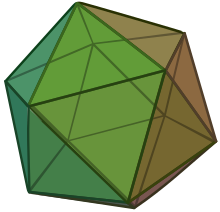
Back Ікасаэдр Byelorussian Korrapärane ikosaeeder Estonian עשרימון משוכלל HE Կանոնավոր քսանանիստ Armenian Ուղղաձեւ քսանանիստ HYW Ikosahedron beraturan ID 正二十面体 Japanese 정이십면체 Korean Taisyklingas ikosaedras Lithuanian Икосаедар Macedonian
| Regular icosahedron | |
|---|---|
 | |
| Type | Gyroelongated bipyramid Deltahedron |
| Faces | 20 |
| Edges | 30 |
| Vertices | 12 |
| Vertex configuration | |
| Symmetry group | Icosahedral symmetry |
| Dihedral angle (degrees) | 138.190 (approximately) |
| Dual polyhedron | Regular dodecahedron |
| Properties | convex, composite |
| Net | |
 | |
In geometry, the regular icosahedron (or simply icosahedron) is a convex polyhedron that can be constructed from pentagonal antiprism by attaching two pentagonal pyramids with regular faces to each of its pentagonal faces, or by putting points onto the cube. The resulting polyhedron has 20 equilateral triangles as its faces, 30 edges, and 12 vertices. It is an example of a Platonic solid and of a deltahedron. The icosahedral graph represents the skeleton of a regular icosahedron.
Many polyhedra are constructed from the regular icosahedron. A notable example is the stellation of regular icosahedron, which consists of 59 polyhedrons. The great dodecahedron, one of the Kepler–Poinsot polyhedra constructed by either stellation or faceting. Some of the Johnson solids can be constructed by removing the pentagonal pyramids. The regular icosahedron's dual polyhedron is the regular dodecahedron, and their relation has a historical background on the comparison mensuration. It also has many relations with other polytopes.
The appearance of regular icosahedron can be found in nature, such as the virus with icosahedral-shaped shells and radiolarians. Other applications of the regular icosahedron are the usage of its net in cartography, twenty-sided dice that may have been found in ancient times, and role-playing games.

